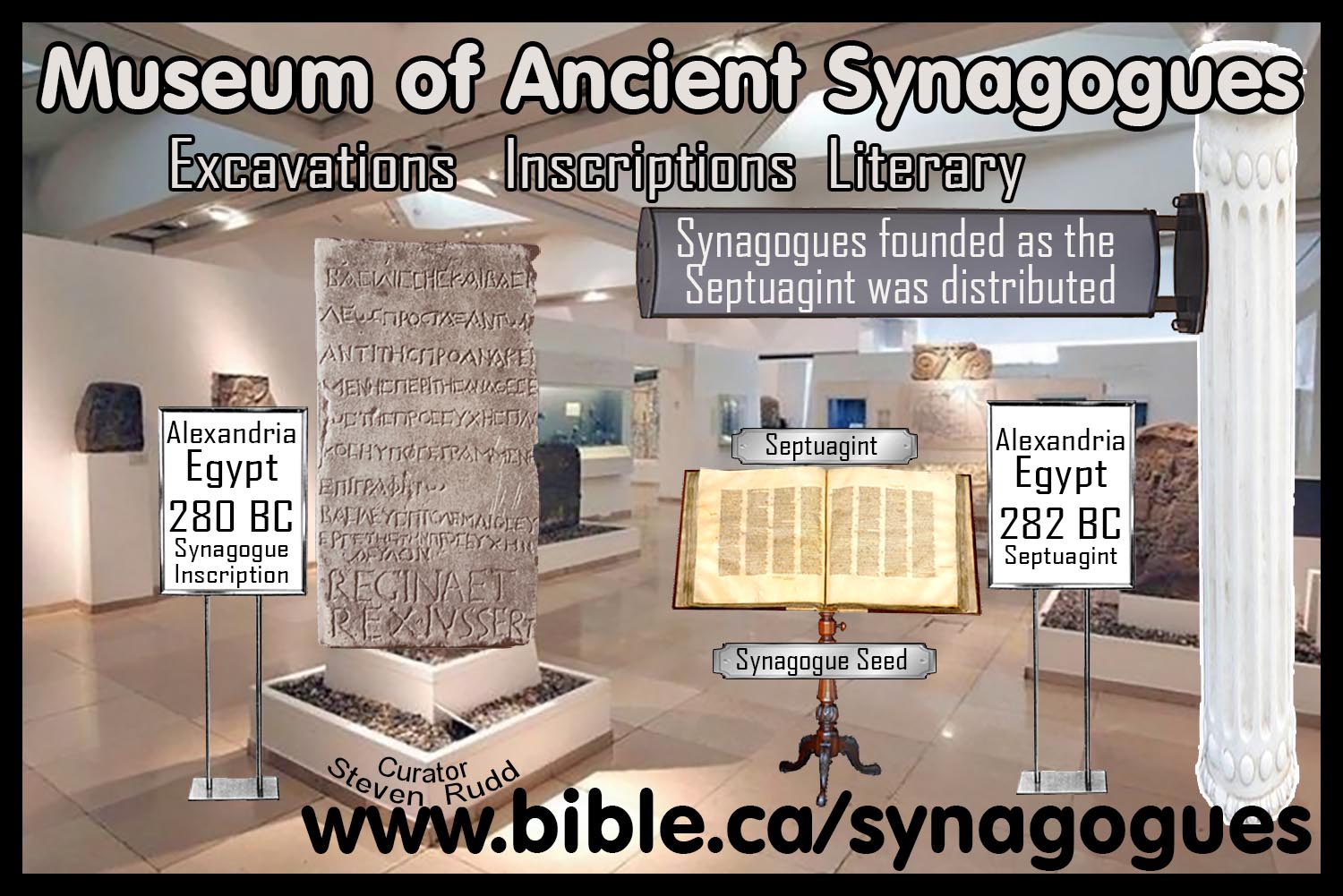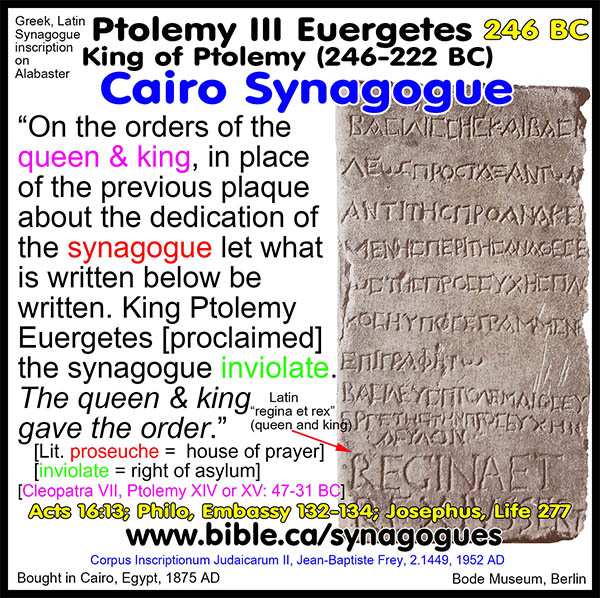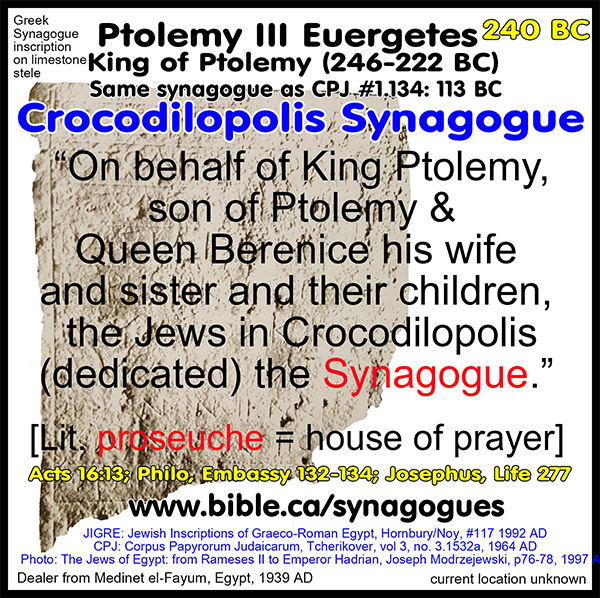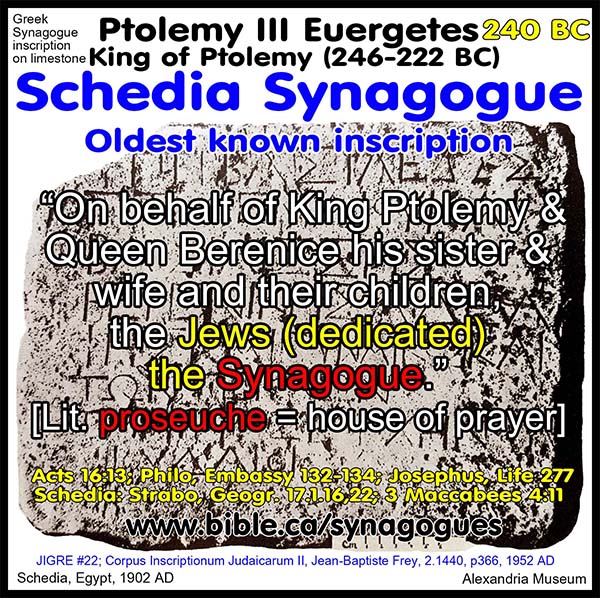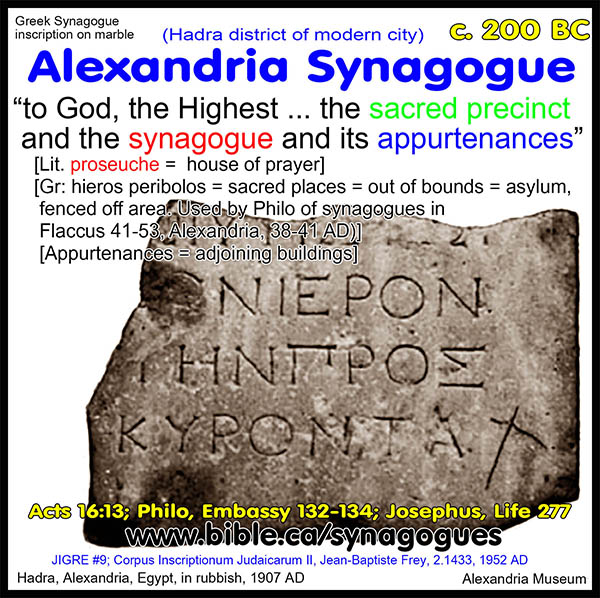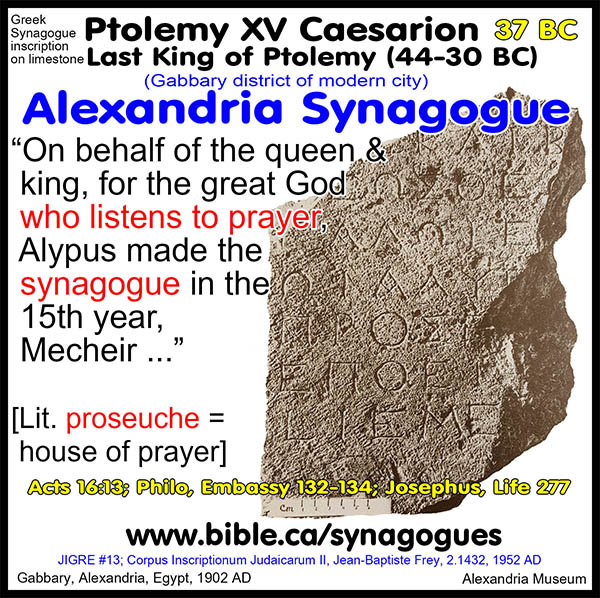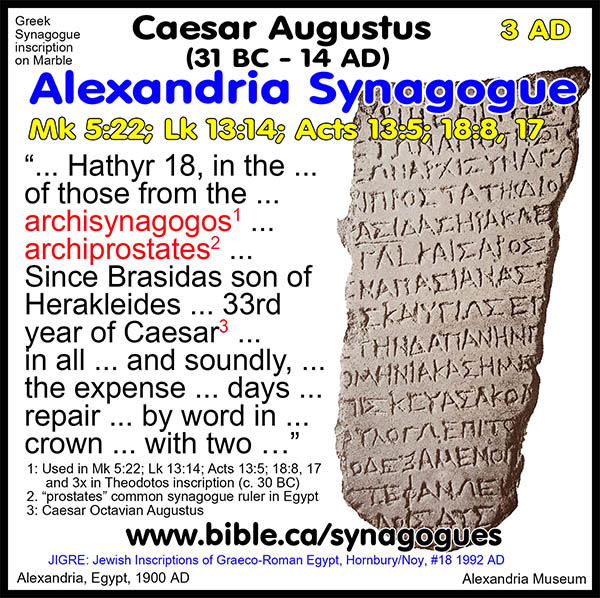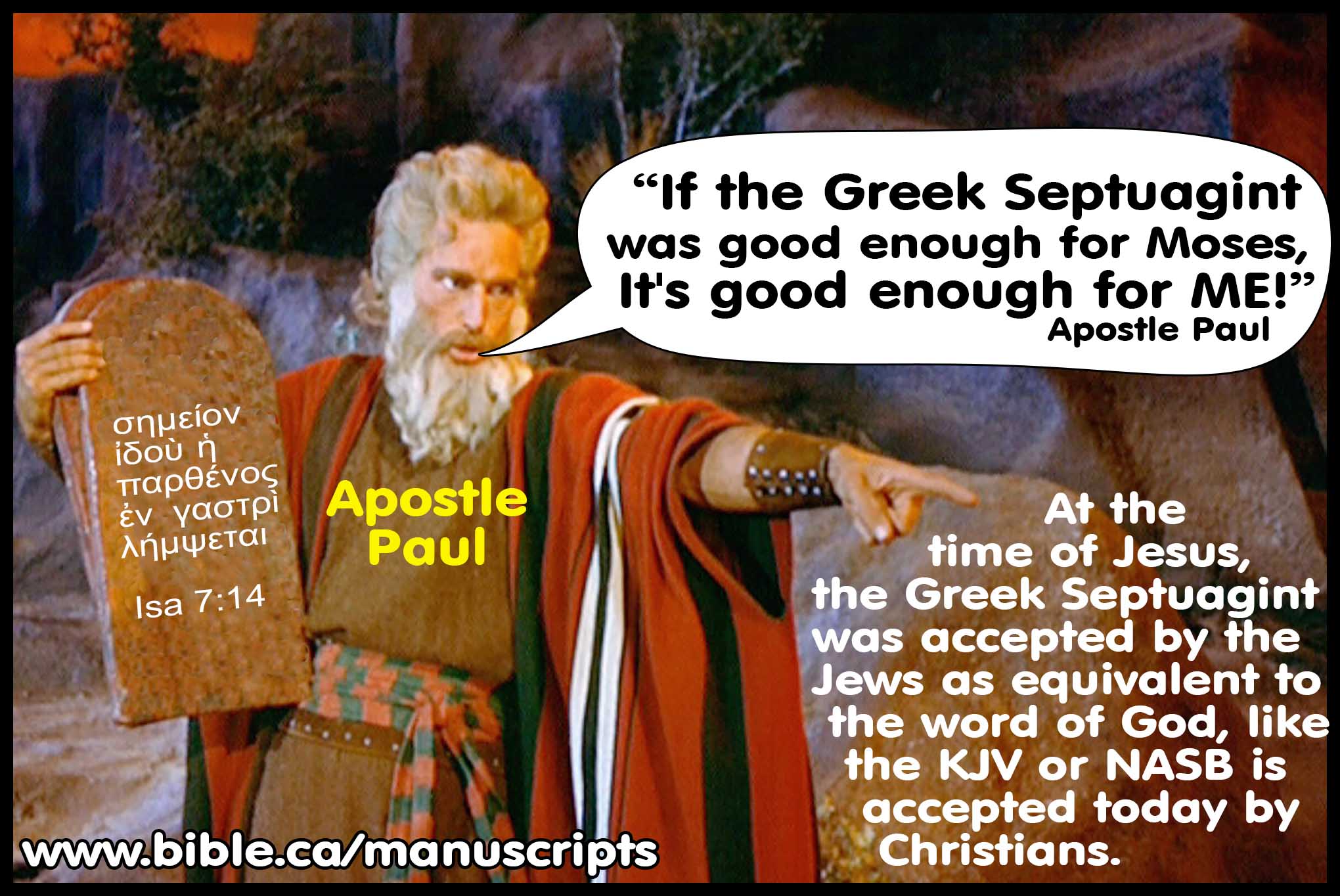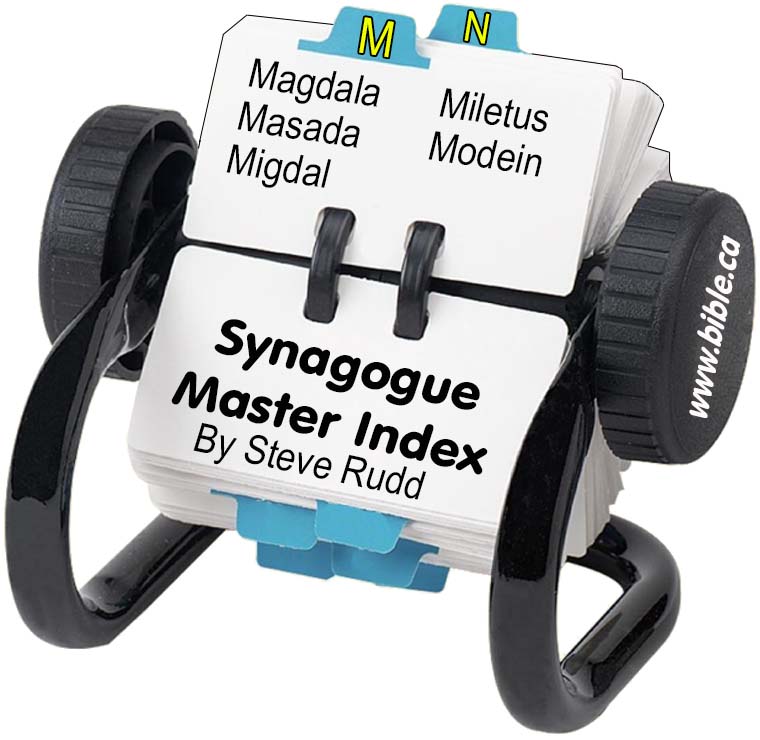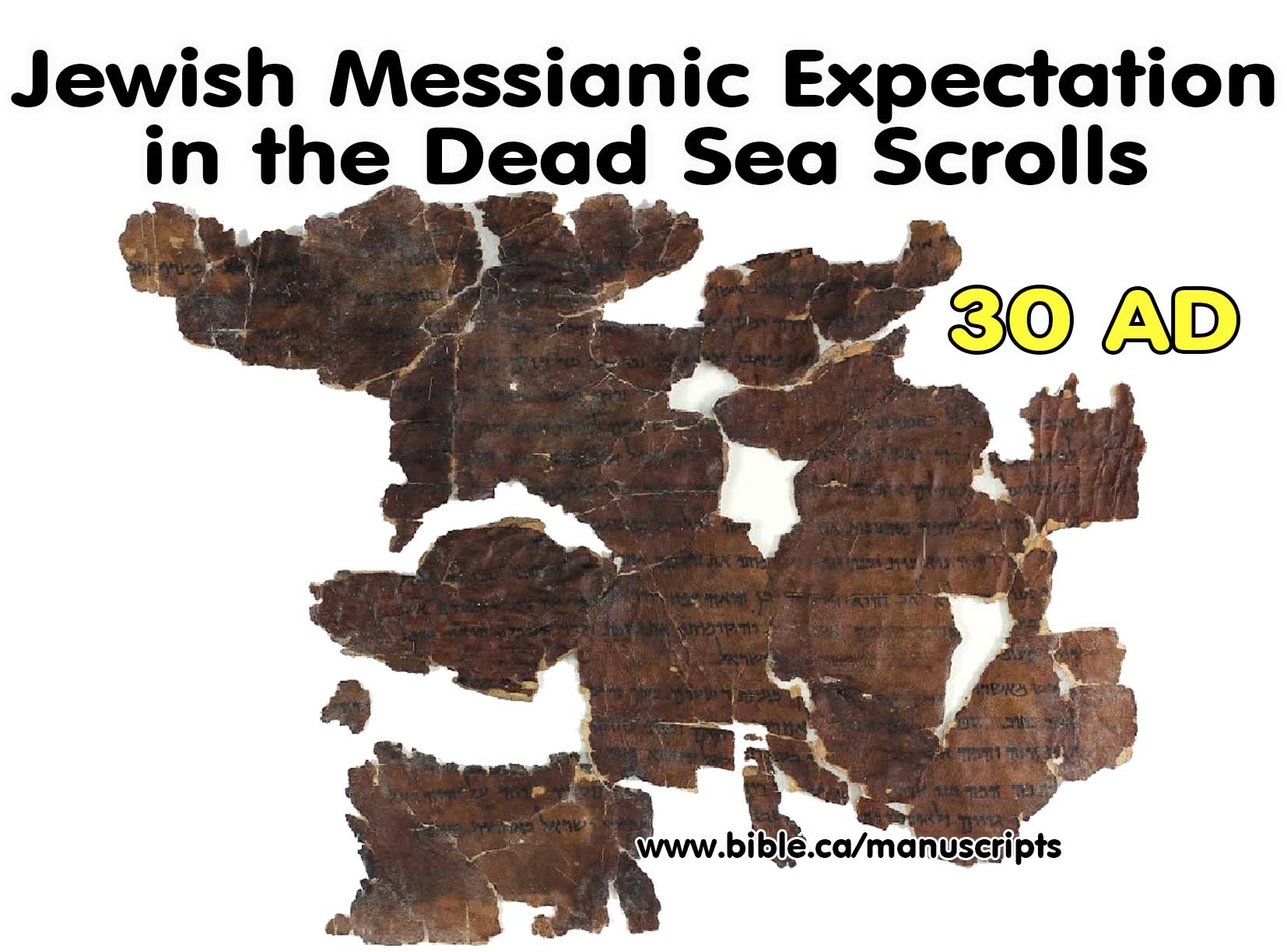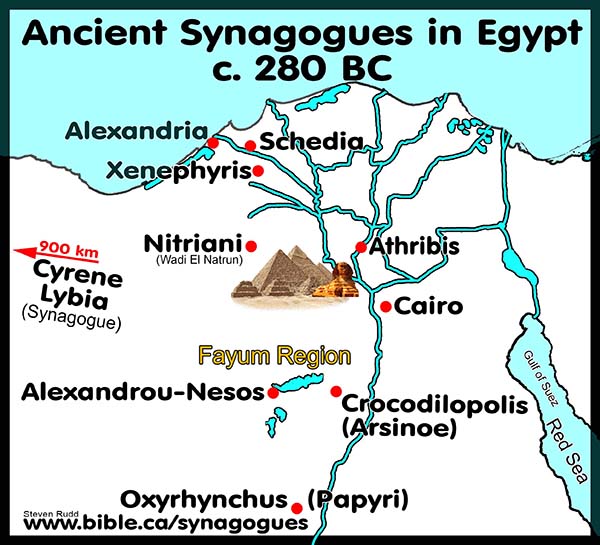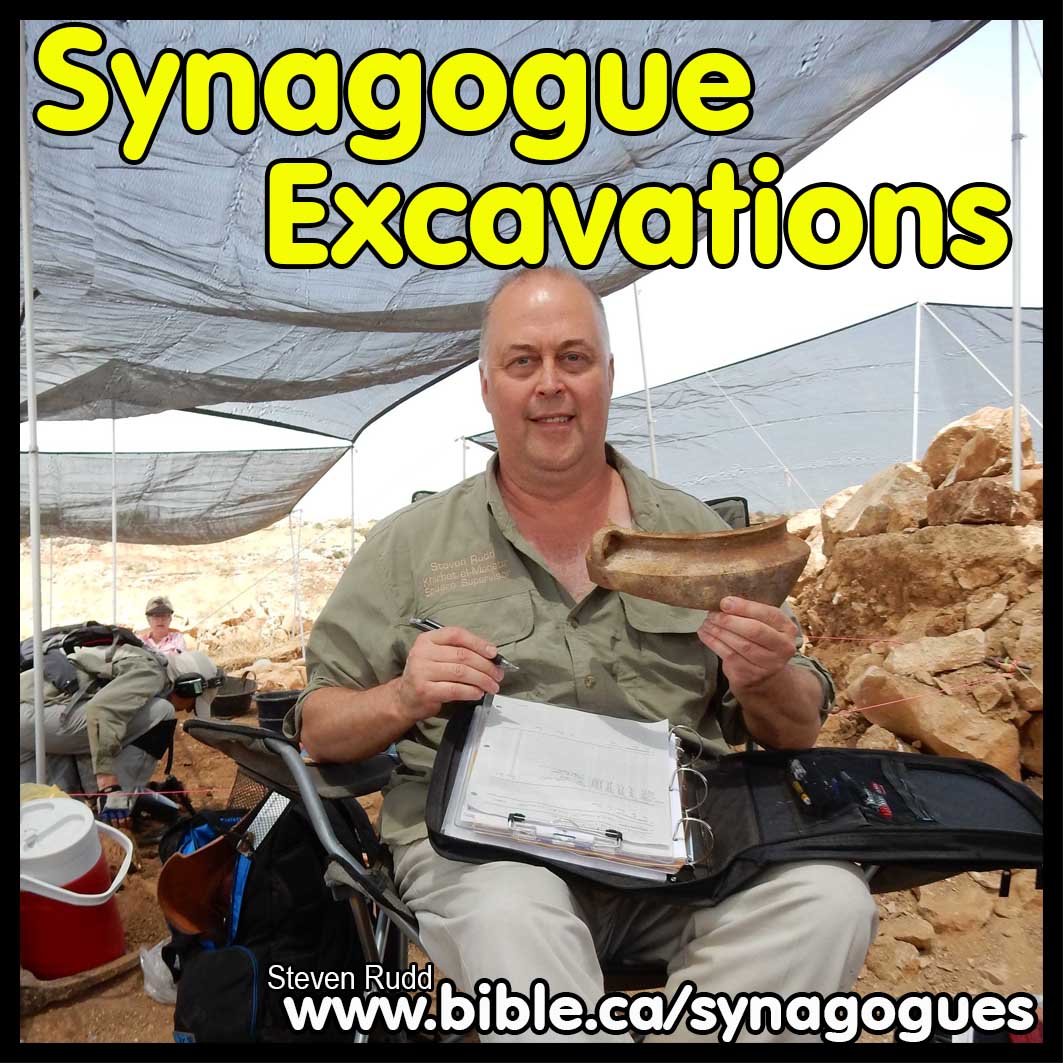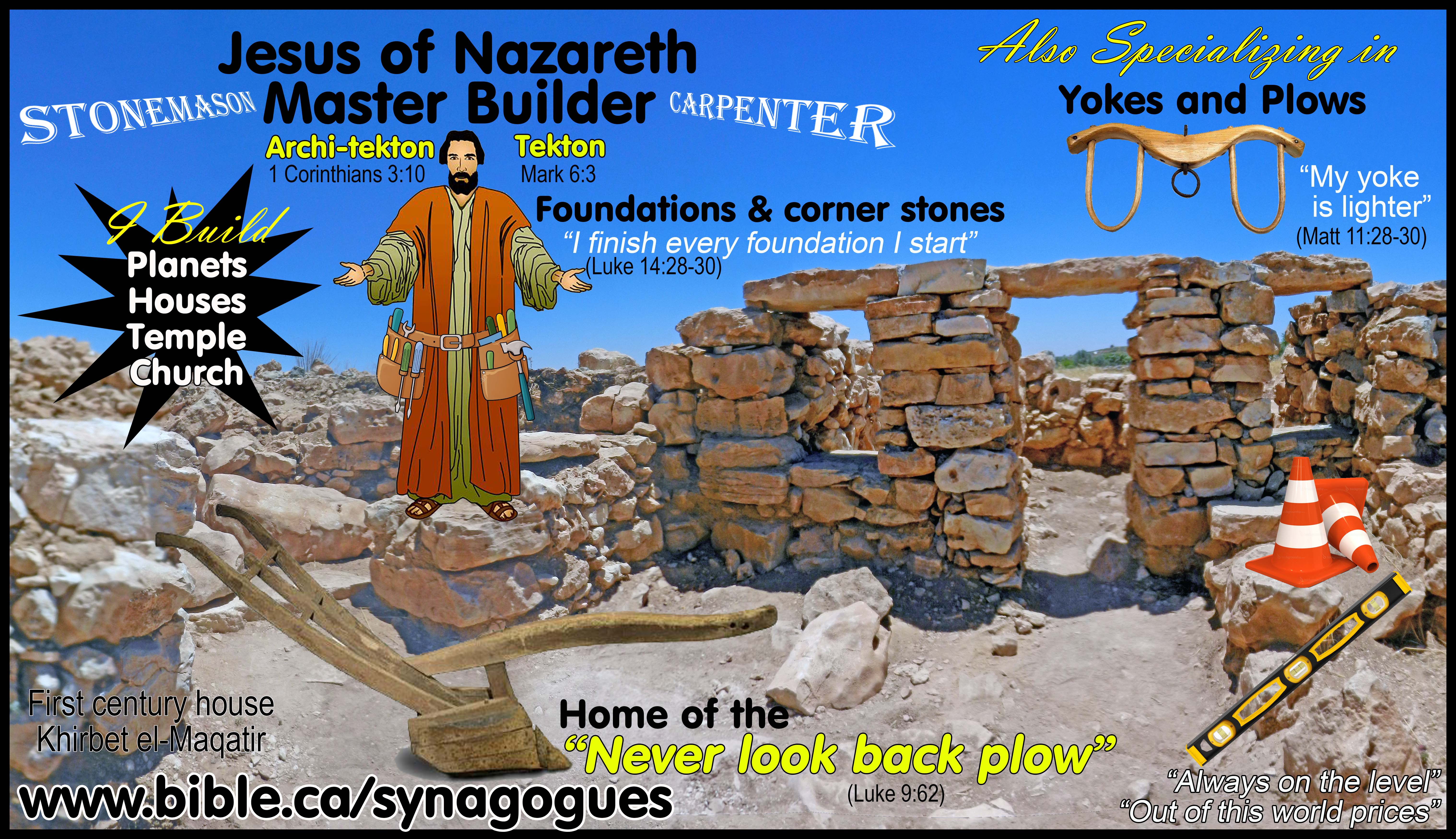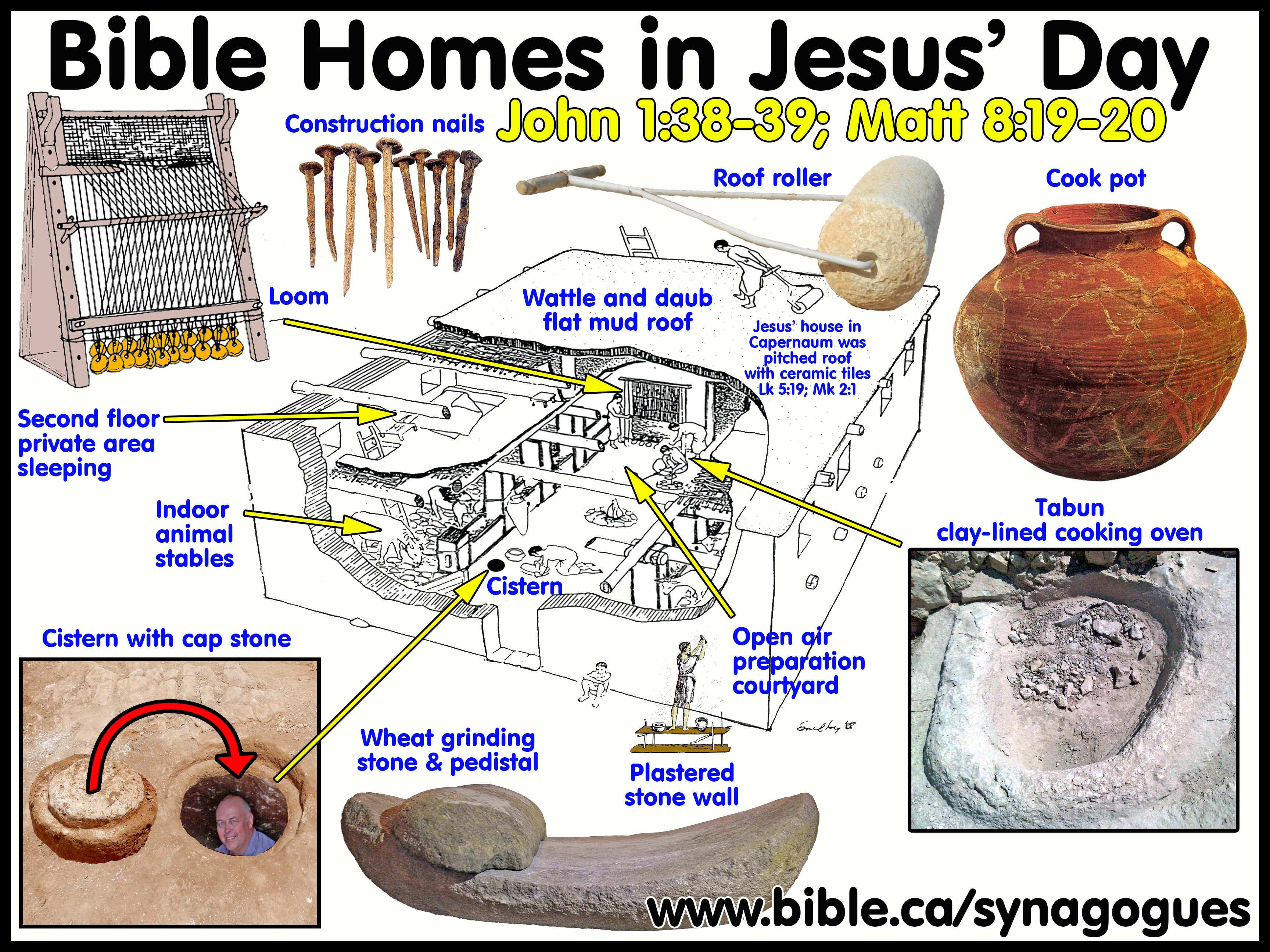Ten Reasons why the Origin of Synagogues is in Alexandria Egypt in 280 BC
The first synagogue was the great Basilica Synagogue of Alexandria and
spread throughout the world as the Septuagint was distributed.
The global distribution of the Septuagint was the engine that spawned the birth of Synagogues
as a part of God’s eternal plan to create a bridge between temple worship and the Christian Church.
Introduction:
1. Although Ptolemy II wanted the Jewish scriptures translated into Greek in 282 BC for his father’s (Ptolemy I) famous Library of Alexandra, the local Jews quickly made copies and started to gather to read the “Bible for themselves” and of course pray. The very first synagogue in the world was started when a small group of very excited Jews agreed to gather together in someone’s home to pray and read the Greek Tanakh, which at this point consisted only of the first five books of Moses. The first and oldest word for a synagogue is the Greek word, “proseuche” and it means “house of prayer”. The first synagogues were in “houses” (ie. HOUSE of prayer). As more copies of the Septuagint were produced combined with the large numbers who wanted to participate in the devotional sabbath prayers and readings, there was an explosion of “house synagogues”. Copies of the Septuagint were quickly sent to all the major diaspora populations of Jews throughout the world as seen in the Delos synagogue which dates to about 250 BC. From the archeological record of extant synagogue inscriptions, the first formal synagogue buildings were either converted from houses or built from scratch, at the time of Ptolemy III. (246 BC) Indeed, the three oldest synagogue inscriptions all dedicate the synagogue to Ptolemy III in the cities of Cairo, Crocodilopolis and Schedia in Egypt.
2. For those who mistakenly place the origin of synagogues in Babylon, there are zero second temple inscriptions, zero excavations and zero literary sources to offer support for that theory.
3. Synagogues began in Alexandria Egypt in 280 BC:
a. “As early as 1971 M. Hengel argued for a Hellenistic Egyptian origin of the synagogue. He builds his argument upon the evidence provided by the inscriptions mentioned above and tries to understand Egyptian synagogues in terms of a Jewish form of the Hellenistic religious association, which was prevalent in Ptolemaic Egypt. However, up to the present date no ancient synagogue building has been discovered in Egypt.” (The Ancient Synagogue from it origins to 200 CE, Birger Olsson, Meeting community Synagogue, p148, 2003 AD)
b. “By way of contrast there is firm evidence for the existence of synagogues in Egypt in the third century BCE. Even before this the Jews in Egypt, at Elephantine, had established a temple of Yahweh (in the form Yah or Yaho), and it is relevant to our theme that there are clear signs of the penetration of Egyptian religious cults into the life of the community.” (The Cambridge History of Judaism: The early Roman period, Volume 3, p1028, 1999 AD)
c.
The Hebrew temple at Elephantine was a one of
a kind location on the southern border of Egypt with Nubia on the island of
Elephantine at the third cataract of the Nile. While interesting, it really has
little to do with the origin of synagogues.
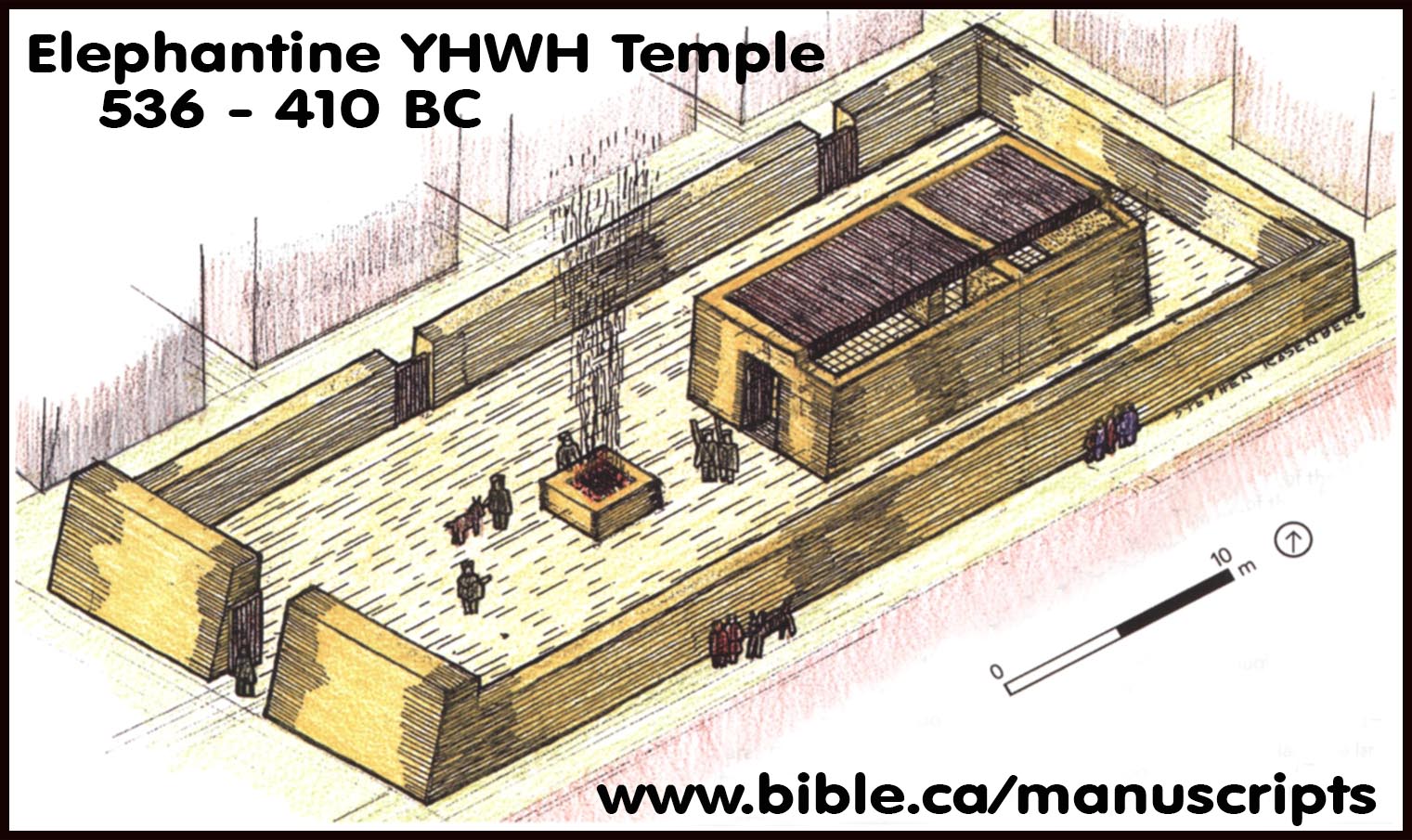
d. “However, the existence of synagogues in the Egypt of the third century BCE is firmly attested in the archaeological and epigraphic record, and the attestation includes an assured date. One inscription on a limestone slab now in the Alexandria Museum comes from Schedia, and according to G. Botti, who acquired it for the museum and provided the earliest description of it,"' it was brought to him with a funerary epitaph of the early Ptolemaic era, but with no details of an archaeological context beyond its being discovered in Schedia. This is a disappointing gap, for the inscription must have figured in the synagogue itself, whose foundation it expressly refers to.” (The Cambridge History of Judaism: The early Roman period, Volume 3, p1029, 1999 AD)
e. “On the basis of our extant sources, the first appearance of buildings intended for religious and communal purposes was in the Diaspora during the third century B.C.E. Such buildings are documented in Egypt for the third and subsequent centuries. In Israel, the synagogue probably first made its appearance during the Hasmonean or Herodian periods, during the first century B.C.E.” (The Synagogue in Late Antiquity, Lee Levine, p10, 1987 AD)
4. “The first archeological evidence for a synagogue appears in Schedia, near Alexandria in Egypt, in the third century bce. Although no synagogues are clearly attested during the period of Ezra and Nehemiah (late fifth and early fourth centuries bce), the tradition traces the practice of translating Scripture from Hebrew into Aramaic during a public reading to Ezra’s reading of the Torah to the people of Jerusalem (Nehemiah 8; b. B. Qam. 82a; Ber. 33a; Meg. 17b). According to Neh 8:7*, the Levites helped the people to understand the Torah by interpreting or giving meaning to the words.” (Zephaniah, M. A. Sweeney, p30, Targum Zephaniah 2003 AD)
5. Huge Jewish population in Egypt:
a. "Jewish immigration into Egypt from Palestine had begun as early as the 6th century b.c.e., and Jews flowed into the new city in large numbers almost from the beginning, many as prisoners of war. (Josephus reports that Alexander himself settled Jews in the city, JW 2.487; cf. AgAp 2.35.) The earliest archeological evidence for the Jewish community of Alexandria consists of tombs in the E necropolis of Ibrahimiya dating to the time of Ptolemy II, or perhaps as early as Ptolemy I (323–285 b.c.e.)." (ABD, Alexandria)
b. "We are best informed about the Jewish communities in Egypt, which were the largest Diaspora communities in our period. At the time of the Babylonian conquest some Jews fled to Egypt (Jer 43:6–7; 44:1; 46:14); Aramaic papyri of the fifth century .B.C.. give evidence of a Jewish military colony at Elephantine, a colony that included a Jewish temple. Jewish immigration into Egypt, both forced and voluntary, was significant from the third century .B.C.., with the result that Jews came to be settled throughout Egypt. The Ptolemaic era was a period when the Jews in Egypt encountered little hostility (although there were some notable exceptions) and came to fill a significant and prominent role in the economic, political, military and social life of Egypt. They generally flourished as Jews who retained their ethnic identity while also being strongly attracted to Hellenistic culture. However, their position was also precarious, since they had become alienated from significant sections of the wider populace. At Leontopolis there was another significant Jewish community, formed by Jewish military settlers around 160 .B.C.. and including the Temple of Onias, which served the needs of the military colony (Tcherikover and Fuks, hereafter CPJ, 3:145–63; Josephus Ant. 13.3.1–3 §62–73). In Philo’s day Jews lived throughout Alexandria but were particularly concentrated in two of its five quarters (Philo Flacc. 55; Josephus J.W. 2.18.8 §495). Synagogues were to be found throughout the city (Philo Leg. Gai. 132). Octavian reaffirmed the privileges of the Jewish community in Egypt when he annexed that country in 30 .B.C.. The Romans also redefined the various classes of the population and emphasized the distinctions Romans, citizens of Greek cities and “foreigners.” The Jews seem to have been relegated en bloc to the same category as the Egyptians and thus were compelled to pay the poll tax (laographia); Romans and citizens of Greek cities were exempted from paying this tax or paid at a lower rate. This was not only a financial burden; to be grouped with the native Egyptians was also a grave cultural affront, particularly to the upper classes of the Jewish population. Hence the matter of civic status became an increasingly important one for some Jews. Thus began a period of decline for the Jews in Egypt. Jewish-Greek tension erupted in A.D. 38, when the Greeks destroyed synagogues or put up images of Gaius inside them. Flaccus, the Roman governor, declared the Jews to be “foreigners and aliens” in Alexandria and ordered them all to live in one section of the city (Philo Flacc. 25–57; Leg. Gai. 120–35). Murder of Jews and widespread looting also occurred. Flaccus was subsequently dismissed from office, and both sides sent delegations to Caligula, who died in A.D. 41 before giving his decision on the matter of Jewish communal privileges, which Flaccus had annulled. Further trouble erupted in A.D. 41, which led to hearings before Claudius. He wrote a letter to the city (CPJ 153; cf. Josephus Ant. 19.5.2 §280–85) in which he called upon the Alexandrians to allow the Jews to keep their customs and ordered the Jews not to seek any privileges beyond those they had enjoyed for a long period. He also forbade the Jews from participating in the gymnasium and told them to be satisfied with the benefits they were enjoying in “a city not their own.” Both these last factors support the view that the Jews had never possessed citizenship rights as a body in the city (Smallwood, 235–55). However, it seems clear that some Jews had become citizens individually. Claudius’s letter halted the social and cultural integration of such Jews and their children. The conflict between Jews and Greeks erupted again in A.D. 66 and resulted in the slaughter of a large number of Jews (Josephus J.W. 2.18.7–8 §487–98). After the Jewish war some of the most zealous insurgents escaped to Egypt, where they endeavored to stir up the Jewish population against the Romans, although they met strong opposition from the leaders of the Jewish community (Josephus J.W. 7.10.1 §409–19). In A.D. 115–17 Jews in Egypt, Cyrenaica, Cyprus and Mesopotamia attacked their Greek neighbors and launched a revolt. The loss of life was huge, and the Diaspora communities concerned were decimated as a result. Messianic expectation, resentment against the local population and radical social disaffection seem to have been factors behind this revolt." (Dictionary of the Later New Testament & Its Developments, A Geographical Survey of Diaspora Communities , p289, 1997 AD)
I. Ten reasons why Synagogues began Alexandria, Egypt in 280 BC as part of God’s master plan for the Christian church.
There are many important historical and archeological markers that point to the origin of Synagogues at Alexandrian in Egypt at 280 BC.
1. In preparation for the Greek New Testament, Alexander the Great makes Greek the universal language of the world in 333 BC because Hebrew would be extinct at the time of Christ.
a. God knew Hebrew would be extinct as a language in the first century AD.
b. The Diaspora Jews outside Judea spoke Greek while the Judean Jews spoke Aramaic as their default language and Greek as their working language.
c. The only Jews who spoke Hebrew at the time of Christ were the Temple elites (Sadducees, High priest).
d.
At the time of Christ, the High priest would conduct Temple worship
services in Hebrew to a Greek speaking audience who didn’t understand a word he
was saying. This made the Jerusalem temple “out of touch” with the people and
drove them to synagogue worship, conducted in Hebrew, for their spiritual
needs. This is like the Roman Catholic church today, that conducts Mass in
Latin to an English only speaking audience who don’t understand a word.
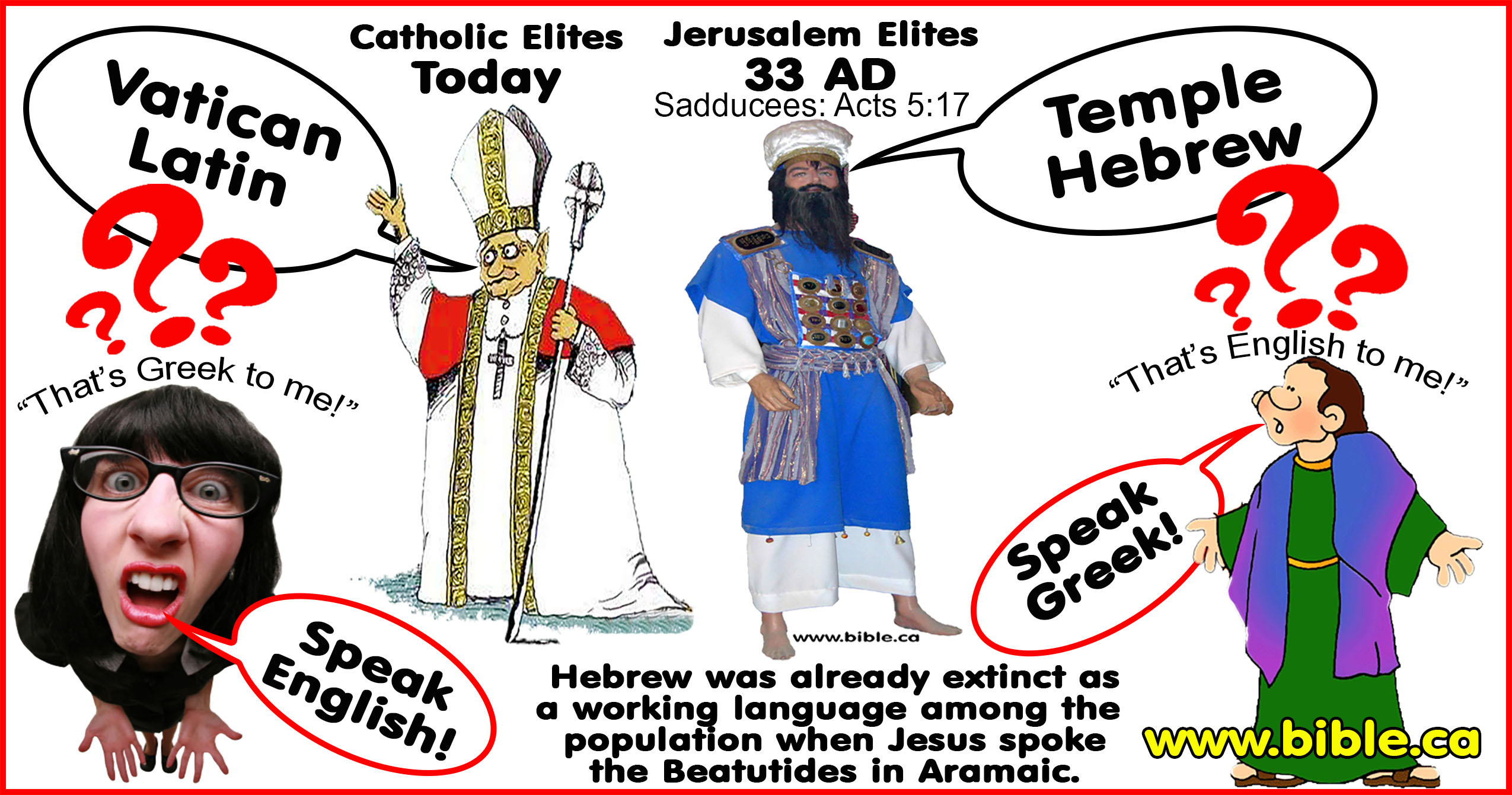
2. Ptolemy I founds the library of Alexandria as one of the 7 wonders of the world: (323-282 BC).
a. This is a huge historical marker because if the Library of Alexandria was never build the Septuagint (LXX) never would have existed.
b. Without the LXX (Septuagint) the Christian church would not have the inspired Old Testament in Greek.
c. Alexandria, because of this library, became the intellectual capital of the Greek world where people had a hunger and thirst for reading books and learning.
d. This awakening in Alexandria for studying books made the establishment of “houses of prayer” (synagogues) even more certain as the Jews would study the new Greek Torah.
3.
Ptolemy II translates Torah into Greek (Septuagint) for the Library of
Alexandria: 282 BC and all 39 books of the Old Testament (Tanakh) were
translated into Greek before 130 BC and as early as 260 BC.
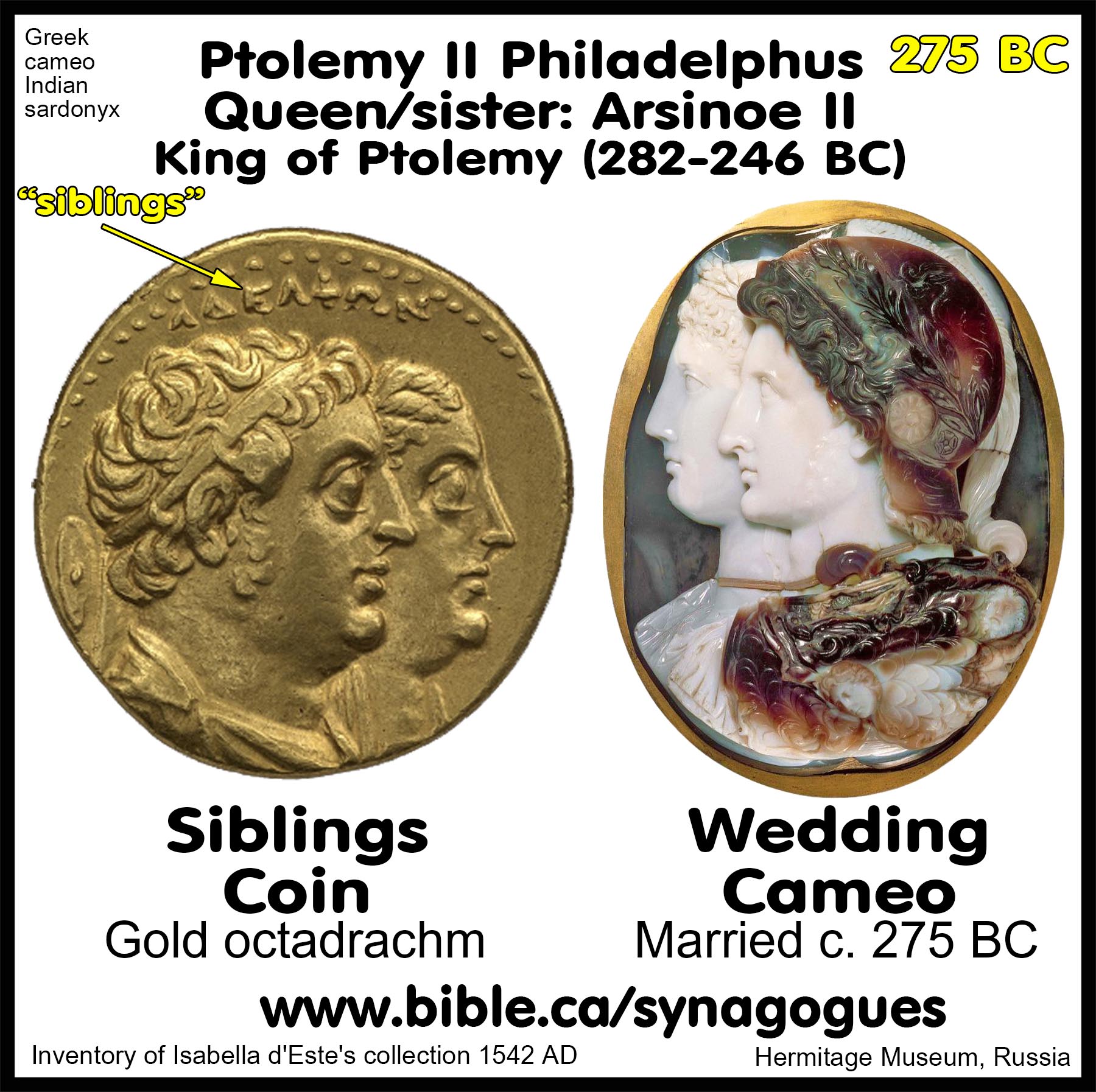
a. “Ptolemy II sent envoys bearing gifts to the high priest in Jerusalem. The envoys were to ask not only for copies of the five books of Moses, but also for a group of scholars to translate them into Greek. The high priest met the request and sent 72 scholars to Alexandria. It is said that each of them worked alone to complete the difficult and unprecedented task. When they were finished and the translations were compared, each of the 72 is said to have been identical. Thus, this Greek translation of the Bible was called the Septuagint or "the seventy." Now, the wisdom of the Jewish nation was available for the first time to others, including those Jews who had been born and raised outside their homeland, as in Alexandria, and had already lost fluency in the Hebrew language.” (Guide to Biblical Coins, David Hendin, 5th edition, p139, 2010 AD)
b. "It is generally agreed that the Pentateuch or Torah was translated from its Hebrew original into Greek during the reign of Ptolemy II Philadelphus (283–246 b.c.), possibly around 280, according to reliable patristic testimony. The books in the Prophets and Writings were translated later, probably all of them by about 130 b.c. as suggested by the Greek Prologue to Ben Sira." (The Septuagint and the Text of the Old Testament, P. J. Gentry, Bulletin for Biblical Research, Vol. 16, p 193, 2006 AD)
c. Isaiah translated into Greek by 150 BC: "Date: According to the generally accepted explanation of the testimony of the Epistle of Aristeas, the Torah translation was carried out in Egypt in the beginning of the third century BCE. This assumption is compatible with the early date of several Greek papyrus and leather fragments of the Torah from Qumran and Egypt, some of which date from the middle of the 3rd century until the 1st century BCE. The remaining Scripture books were translated at different times. Some evidence for their dates is external, e.g. quotations from Ǿ in ancient sources, and some internal, e.g. reflections of historical situations or events found in the translation. The post-Pentateuchal books were translated after the translation of the Torah, for most of these translations use its vocabulary, and several translations also quote from the Greek Torah. Since the Prophets and several of the Hagiographa were known in their Greek version to the grandson of Ben Sira at the end of the 2nd century BCE, we may infer that most of them were translated in the beginning of that century or somewhat earlier. There is only limited explicit evidence concerning the dates of individual books: Chronicles is quoted by Eupolemos in the middle of the 2nd century BCE, and Job by Pseudo-Aristeas in the beginning of the 1st century BCE. Swete*, 25-6. The translation of Isaiah contains allusions to historical situations and events that point to the years 170-150 BCE" (Textual Criticism of the Hebrew Bible, Emanuel Tov, p131, 2012 AD)
d.
Two of the oldest Greek fragments of the Septuagint in the world:
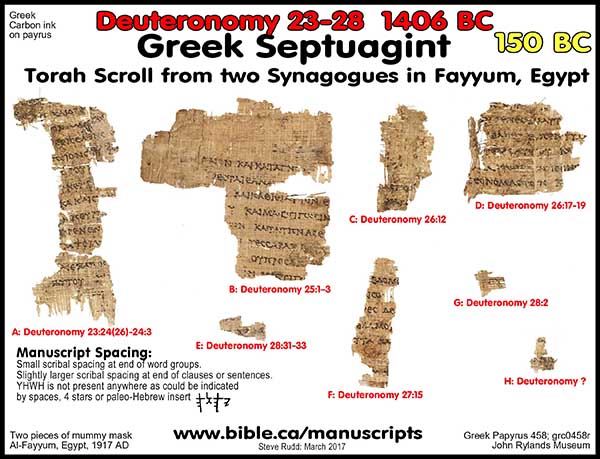
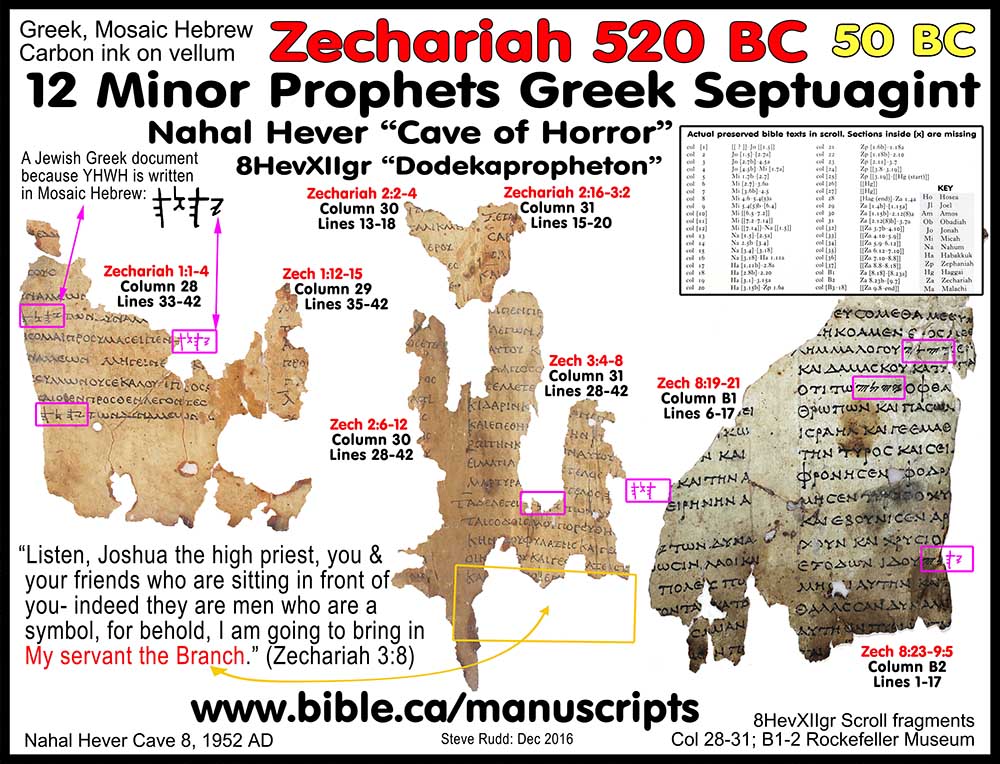
4. The THREE OLDEST synagogue inscriptions ever found are all dedicated to and thanked Ptolemy III.
a. The earliest synagogue inscriptions give high praise to Ptolelmy III for granting the Jews “sanctuary” rights and allowed them to build synagogues.
b. Notice in the Cairo inscription of 246 BC that Ptelemy III Euergetes decreed that all synagogues in Egypt were “inviolate” (right of Asylum).
c. This meant that from the very beginning of the synagogue movement, they had distinct synagogue (Greek: proseuche = prayer halls) buildings that were “no go zones” for non-Jews wherein the local and national governments would not enter inside to arrest anyone.
d. These asylum rights actually continue today in the modern church and National Embassies. Who knew the political refugee guy living in the basement of the Church building was protected by the decree of a Ptolemaic king in 246 BC?
5.
The Most Number of inscriptions of any city is Alexandria at THREE.
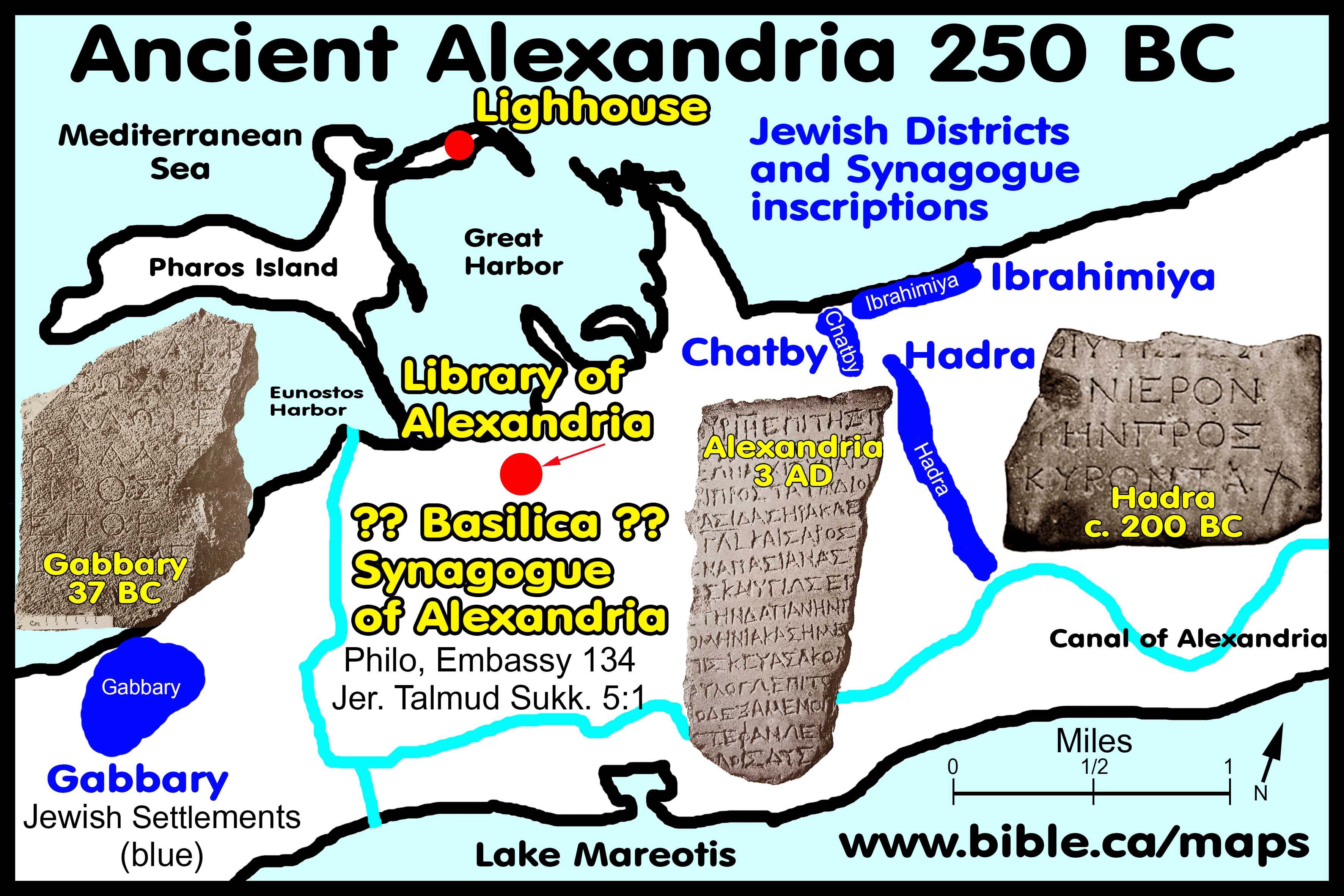
a. Two of the inscriptions were found in Hadra and Gabbary which are are ancient Jewish districts or suburbs of Alexandria.
b. The location of the Great Basilica Synagogue of Alexandria has never been found. It is possible that one of the three inscriptions below are from the Great Basilica Synagogue: See: Philo, Embassy 134 and Jer. Talmud Sukk. 5:1
6. Almost exclusive use of Greek in all synagogue inscriptions everywhere in the world.
a. Outside Judea, close to 100% of the diaspora synagogue inscriptions are in Greek. In Judea, where the default language is Aramaic, 80% of synagogue inscriptions are Greek.
b. "The evidence of Greco-Roman influence there is overwhelming—the architecture of many catacomb facades, the impressive funerary monuments, the extensive art remains, and especially the inscriptions, almost 80% of which are in Greek. Soon after these discoveries, and at least in part because of them, S. Lieberman published his seminal and monumental Greek in Jewish Palestine, a pioneering work demonstrating the degree of penetration of Greek language and culture into Jewish life generally and among the rabbis in particular." (The Revolutionary Effects of Archaeology on the Study of Jewish History: The Case of the Ancient Synagogue, L. I. Levine, The archaeology of Israel: Constructing the Past, Interpreting the Present, N. A. Silberman & D. Small, Vol. 237, p181, 1997 AD)
c. Another study found that only 12% of Judean synagogue inscriptions were in Hebrew: "A recent survey [1970's] of Palestinian synagogue inscriptions revealed that 67 were in Greek, 54 were in Aramaic and 14 in Hebrew. Most of the Greek inscriptions were found in the coastal and important inland cities." (Caesarea under Roman rule, Lee Levine, Chapter 5, footnote 126, p198, 1975 AD)
d. "The large quantity of archaeological finds relating to ancient synagogues is an important factor in any discussion of Hellenization and its effects in late antiquity. … Finally, the use of Aramaic and Greek, both lingua franca in the Roman East, in over 90% of the synagogue inscriptions in Palestine, bears testimony to the impact of the surrounding world. Many of the names of donors, particularly those in Greek, as well as the formulae invoked in many Greek inscriptions, were likewise borrowed from outside usage. (The Revolutionary Effects of Archaeology on the Study of Jewish History: The Case of the Ancient Synagogue, L. I. Levine, The archaeology of Israel: Constructing the Past, Interpreting the Present, N. A. Silberman & D. Small, Vol. 237, p181, 1997 AD)
7. The Great Basilica Synagogue of Alexandria is oldest and most opulent synagogue before 41 AD witnessed by both Philo and the Mishnah as a witness to its pre-eminence.
a. The great Basilica synagogue at Alexandria was fully operational in 41 AD and destroyed by Trajan in 117 AD.
b. It was called the “Glory of Israel” and featured a row of columns inside another row of columns and 71 golden chairs or thrones.
c. It is the first and largest and most famous and most celebrated synagogue on earth in 41 AD.
d. Philo: “the largest, and most famous, and most celebrated [The Great Alexandria Synagogue]” (Philo, Embassy/Legat. 132-139, Alexandria, 41 AD)
e. Text of Jerusalem Talmud, y. Sukk. 5:1, I.5.A–H: “It has been taught [in Tosefta Sukkah 4:6A-G, 250 AD]: Said R. Judah, “Whoever has never seen the double colonnade [the basilica-synagogue] of Alexandria in Egypt has never seen Israel’s glory in his entire life. [B] “It was a kind of large basilica, with one colonnade inside another. [C] “Sometimes there were [55b] twice as many people there as those who went forth from Egypt. [D] “Now there were seventy-one [Y.: seventy] golden thrones set up there, one for each of the seventy-one elders, each one worth twenty-five talents of gold, with a wooden platform in the middle. [E] “The minister of the synagogue stands on it, with flags in his hand. When one began to read, the other would wave the flags so the people would answer, ‘Amen,’ for each and every blessing. Then that one would wave the flags, and they would answer, ‘Amen.’ [F] “They did not sit in a jumble, but the goldsmiths sat by themselves, the silversmiths by themselves, the weavers by themselves, the bronze-workers by themselves, and the blacksmiths by themselves. [G] “All this why? So that when a traveller came along, [he could find his fellow craftsmen,] and on that basis he could gain a living” [T. Suk. 4:6]. [H] And who destroyed it all? It was the evil Trajan.” (Jerusalem Talmud, y. Sukk. 5:1, I.5.A–H, describing the second temple synagogue in Alexandria, 400 AD)
8. Philo’s “300 years” explicitly dates the origin of Synagogues to 262 BC:
a. “From ten kings or more who reigned in order, for three hundred years [ie. 262 BC] never once did one king have an image or statue of themselves erected in any one of our many synagogues in each district of our cities in Egypt” (Philo, Embassy/Legat. 121-124; 132-134, Alexandria, 38 AD)
b. 38 AD - 300 years = 262 BC for the origin of Synagogues.
c. Jephthah’s famous “300 years” is used to date the exodus conquest to 1406 BC, since he made the statement in 1100 BC. Likewise we can use Philo’s famous “300 years” to date the origin of synagogues in 262 BC since he made the statement in 38 AD.
9. Archeological excavation of synagogues that date to as early as 250 BC (Delos).
a. I have compiled to plans of 14 different second temple period synagogues.
b. Below is Magdala on the western shore of the sea of Galilee that dates to 50 BC.
c.
The discovery of Magdala silenced the “skeptics and Bible trashers” who
say the New Testament was wrong when it says synagogues existed before 70 AD.
These revisionists say that Jesus and Paul never preached in a synagogue in
spite of the historical accounts of the Gospels and the book of Acts.
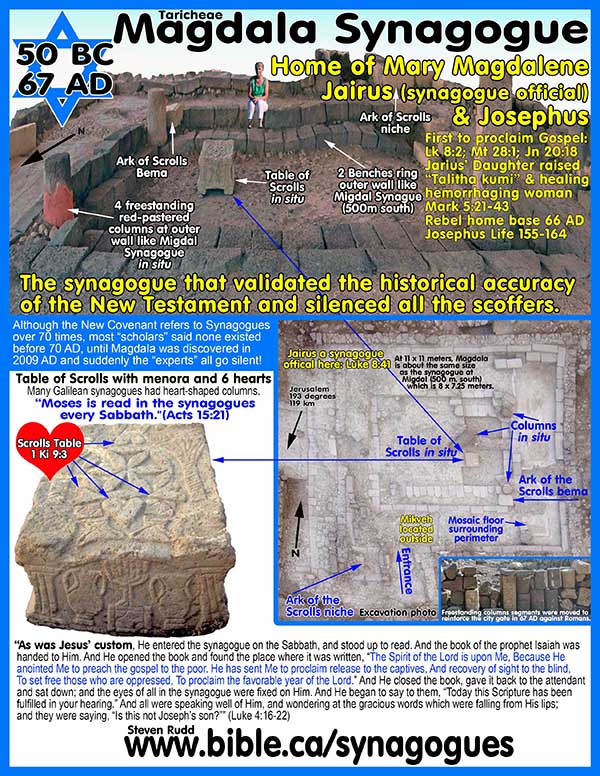
10. Viewing Synagogues as a Divinely guided providential intermediate step between Mosaic temple worship and the Christian church, is a perfect fit to observable history:
a. We know from the prophecy of Dan 2:44 traces a providential path from the Judean Davidic monarchy, through Babylon, Persia, Greece, Rome and finally the church.
b. "In the days of those kings the God of heaven will set up a kingdom [THE CHURCH] which will never be destroyed, and that kingdom will not be left for another people; it will crush and put an end to all these kingdoms, but it will itself endure forever." (Daniel 2:44)
c. At a very minimum, it is clear that God foresaw the rise of Christianity since the death of the Jesus on the cross was part of God’s plan from before the creation of the worlds and first proclaimed in the Garden of Eden: “You [Satan] will bruise Him [Messiah Jesus] on the heel [on the cross] but He [Messiah] will bruise you [Satan] on the Head” Gen 3:15.
d. The similarities between synagogue worship and organization are very close but there are huge differences between the Temple and both the Synagogue and church.
e. Only when you view the plan of God in five kingdoms of Daniel 2 as a purposeful scattering of Jews to ever corner of the world, each speaking Greek, with thousands of synagogues in every city of the world and in each synagogue a Greek Septuagint as preparatory step, setting the stage for the Apostle Paul to preach the good News about the blood of Jesus saving mankind from their sins, does the role of synagogues become clear.
f. Synagogues followed the distribution of the Septuagint in preparation for Christianity: "Finally, it should be noted that the LXX translation functioned as a praeparatio evangelica for the first mission and expansion of early Christianity. When Paul went round the synagogues of Asia Minor proclaiming the gospel, besides Jews he met among his listeners many proselytes (Acts 2:10; 6:5 and 13:43) already converted to Jewish monotheism, probably through reading the LXX in the synagogue." (The Septuagint in Context: Introduction to the Greek Version of the Bible, Marcos, N. Fernández, p323, 2000 AD)
g. "The LXX was the Bible of the authors of the New Testament. Its ubiquity can be seen not only in the quotations from the Old Testament in the New but also in the hermeneutic techniques and in many other forms of influence. There are certain Old Testament passages that following a sequence of keywords from the LXX are used as an inspiration and a model for the redaction of certain chapters in the gospels, the Acts of the Apostles and the Apocalypse of John. The LXX was transmitted in Christian circles once it was adopted as the official Bible of the Church. This fact was of tremendous importance for the history of the Greek version." (The Septuagint in Context: Introduction to the Greek Version of the Bible, Marcos, N. Fernández, p338, 2000 AD)
h. At the time of Jesus, the Greek Septuagint (LXX) was accepted by the Jews in their Synagogues as “equivalent to” the Hebrew Tanakh. (Old Testament). Christians today view the English KJV or NASB as “equal to” the Greek and Hebrew originals. Since it was originally translated by 70 Jerusalem scholars in 282 BC, it was distributed as an approved “High priest certified” translation of the Tanakh.
|
“If the Septuagint was good enough for Moses… IT IS GOOD ENOUGH FOR ME!!!” (Apostle Paul)
The Septuagint: Greek translation for a Greek speaking Jewish population at the time of Jesus.
|
II. Ancient Synagogues patterned after ancient city gates: J.E.W.S.
A. There are parallels between the function of synagogues and city gates:
1. “On the assumption, then, that the first-century synagogue served as a center for a variety of communal as well as religious functions and activities, we now are in a position to look for the framework that served the same (or similar) purposes in earlier centuries. When seen in this light, it becomes clear that the location for most, if not all, of these activities in earlier times was the city-gate, the main communal setting in cities and towns in the biblical period. The city-gate as the focal point of communal activity is well attested in biblical and non-biblical literature.” (The Ancient Synagogue, Lee Levine, p29, 1999 AD)
2. “If one looks for a place in the ancient city that may have served some of the functions of the synagogue before this institution actually came into being, then the city-gate has often been suggested as a model. As the focal point of communal life it served a broad variety of mercantile, juridical, military and police functions and was a common place in the whole ancient near east. It is well attested in biblical and non-biblical literature and also through archaeological evidence. Thus especially for the development in Palestine the city-gate may well be seen as a synagogue forerunner.” (The Ancient Synagogue from it origins to 200 CE, Birger Olsson, Meeting community Synagogue, p148, 2003 AD)
3. "A study of the texts in which the term appears shows clearly that the gate, together with the street which lay behind it, just within the walls, was a centre of political and legal activity, as well as of trade . . . the gate was the scene of many activities which, in a western city, were carried on in a central square." (Coming" and "Going" at the City Gate: Coming and Going at the City Gate, Geoffrey Evans, BASOR 150, 1958 AD)
4. “The biblical city gate with its adjoining exterior and interior open spaces: Levine (2000:26-31; 2004:28) proposes this structure as the antecedent, forerunner, or point of origin of the syna-gogue. Almost the same communal and religious activities were performed in these sites: public gatherings, judiciary and court activity, prophetic activity, a place where the kings sat to hear the peoples' complaints, a market place, communal meals. In some ancient Near East cities, religious practice consisted of the worship of gods at the city gate. Levine further claims that the transition from the city gate to the synagogue building occurred in the Hellenistic period, when the city gate underwent a change and became strictly functional. The need for a new setting for the abovementioned activities eventually created the synagogue; the lack of data makes it difficult to indicate a precise date for this transition or to trace the process. Binder (2003:123, and n. 12) agrees with Levine's theories on the synagogue's city gate origins and contends that "local public assemblies moved from city gates to open city squares and finally into specialized synagogue buildings". Claussen (2003:148-150) maintains that the city gate is the forerunner of the synagogue for communal functions "while more religious and educational functions had their original place within the family".” (Ancient Synagogues - Archaeology and Art: New Discoveries and Current Research, Rachel Hachlili, p14, 2013 AD)
B. Ancient city gates in the bible functioned as Courts, Public squares and city centers and the synagogue replaced the ancient function of City gates:
1. Bible city gates served four functions remembered with the acronym J.E.W.S.
|
City Gates: J.E.W.S. |
Ancient Synagogues |
Church |
|
Justice: Deut 17:5; 21:19; 22:24; 1 Ki 22:10; Jer 38:7 |
Scourge, imprison, beat: Mt 23:34; Acts 22:19; (Susanna 28-29, 49-50, 59-60) Jerusalem and Babylonian Talmud, Mishnah |
"are you not competent to constitute the smallest law courts?" (1 Cor 6:1-2) Mt 18:15-20; 2 Cor 13:1; 1 Tim 5:19 |
|
Economy: 2 Kings 7:1 Public vender markets |
No markets but collections were made for local poor and Jerusalem Temple. (Temple: Robbers’ den: Mk 11:17) |
No markets but collections were made for poor and Jerusalem Temple. (1 Tim 5:9; 1 Cor 16:2) |
|
Worship: 2 Kings 23:8; Neh 8:1-4 |
Yes (Babylonian Talmud, m. Ta'an. 4:2 F) |
Acts 20:7; Heb 10:25 |
|
Security: 1 Kings 9:15 |
“Safe House” Refugees |
“Safe House” Refugees |
|
Food eaten in gate: Deut 26:12 |
Sacred meals only, common meals forbidden. Josephus, Ant. 14.214-215. “maẓẓot” is unleavened bread baked by the Jews in their synagogues. It was important to first century ritual purity. Several synagogues had ovens: Masada, Ostia room G. |
Communion only, common meals forbidden (Communion, 1 Cor 11:34 |
2. Ancient cities of the Old Testament were designed very differently from our modern cities
a. Often they had circular walls
b. There were no public buildings inside, only private residences.
c. The “town square” was the city gate were public assemblies were called, court was held and goods were bought and sold.
d. “City hall” was the town gate!
3. Foreign kings set up their thrones in the gates of Jerusalem not inside. This is because the gate was symbolic of the entire city and represented the only public town square:
a. “For, behold, I am calling all the families of the kingdoms of the north,” declares the Lord; “and they will come and they will set each one his throne at the entrance of the gates of Jerusalem, and against all its walls round about and against all the cities of Judah." (Jeremiah 1:15)
b. "Then all the officials of the king of Babylon came in and sat down at the Middle Gate: Nergal-sar-ezer, Samgar-nebu, Sar-sekim the Rab-saris, Nergal-sar-ezer the Rab-mag, and all the rest of the officials of the king of Babylon." (Jeremiah 39:3)
C. Bible city gates as public town squares served four functions: Justice, Economy, Worship, Security (J.E.W.S.)
J (Justice/court):
a. "Now Ephron was sitting among the sons of Heth; and Ephron the Hittite answered Abraham in the hearing of the sons of Heth; even of all who went in at the gate of his city, saying," (Genesis 23:10)
b. "to Abraham for a possession in the presence of the sons of Heth, before all who went in at the gate of his city." (Genesis 23:18)
c. "then his father and mother shall seize him, and bring him out to the elders of his city at the gateway of his hometown." (Deuteronomy 21:19)
d. "then you shall bring out that man or that woman who has done this evil deed to your gates, that is, the man or the woman, and you shall stone them to death." (Deuteronomy 17:5)
e. "then you shall bring them both out to the gate of that city and you shall stone them to death; the girl, because she did not cry out in the city, and the man, because he has violated his neighbor’s wife. Thus you shall purge the evil from among you." (Deuteronomy 22:24)
f. "Now Boaz went up to the gate and sat down there, and behold, the close relative of whom Boaz spoke was passing by, so he said, “Turn aside, friend, sit down here.” And he turned aside and sat down. He took ten men of the elders of the city and said, “Sit down here.” So they sat down." (Ruth 4:1–2)
g. "But as for me, my prayer is to You, O LORD, at an acceptable time; O God, in the greatness of Your lovingkindness, Answer me with Your saving truth." (Psalm 69:13)
h. "Now the king of Israel and Jehoshaphat king of Judah were sitting each on his throne, arrayed in their robes, at the threshing floor at the entrance of the gate of Samaria; and all the prophets were prophesying before them." (1 Kings 22:10)
i. "Who cause a person to be indicted by a word, And ensnare him who adjudicates at the gate, And defraud the one in the right with meaningless arguments." (Isaiah 29:21)
j. "But Ebed-melech the Ethiopian, a eunuch, while he was in the king’s palace, heard that they had put Jeremiah into the cistern. Now the king was sitting in the Gate of Benjamin;" (Jeremiah 38:7)
k. "They hate him who reproves in the gate, And they abhor him who speaks with integrity." (Amos 5:10)
l. "‘These are the things which you should do: speak the truth to one another; judge with truth and judgment for peace in your gates." (Zechariah 8:16)
E (economy):
a. "Then Elisha said, “Listen to the word of the Lord; thus says the Lord, ‘Tomorrow about this time a measure of fine flour will be sold for a shekel, and two measures of barley for a shekel, in the gate of Samaria.’ ”" (2 Kings 7:1)
b. "When you have finished paying all the tithe of your increase in the third year, the year of tithing, then you shall give it to the Levite, to the stranger, to the orphan and to the widow, that they may eat in your gates and be satisfied." (Deuteronomy 26:12)
W (worship):
a. "Then he brought all the priests from the cities of Judah, and defiled the high places where the priests had burned incense, from Geba to Beersheba; and he broke down the high places of the gates which were at the entrance of the gate of Joshua the governor of the city, which were on one’s left at the city gate." (2 Kings 23:8)
b. "And all the people gathered as one man at the square which was in front of the Water Gate, and they asked Ezra the scribe to bring the book of the law of Moses which the Lord had given to Israel. Then Ezra the priest brought the law before the assembly of men, women and all who could listen with understanding, on the first day of the seventh month. He read from it before the square which was in front of the Water Gate from early morning until midday, in the presence of men and women, those who could understand; and all the people were attentive to the book of the law. Ezra the scribe stood at a wooden podium which they had made for the purpose.” (Nehemiah 8:1–4)
c. Archeology proves that city gates were centres for pagan worship at Tel Dan and the bull’s head stele at Bethsaida.
d. “And Israelites who belong to that watch gather together in their towns [ie. In the synagogues in each town is generally accepted] and study the story of the works of creation.” (Mishnah, m. Ta'an. 4:2 F)
S (security):
a. Solomon built six chamber gates, verified by excavations at: Gezer, Megiddo and Hazor. 1 Ki 9:15
b. "Now this is the account of the forced labor which King Solomon levied to build the house of the Lord, his own house, the Millo, the wall of Jerusalem, Hazor, Megiddo, and Gezer." (1 Kings 9:15)
c. Six chamber gates have been excavated at Lachish, Ashdod and Dor.
d. David built 2 four chamber gates at Qeiyafa, (see photo above) one facing south and one facing west as reflected in the Biblical name “Sha'arayim” which literally means “two gates”. Other four chamber gates were excavated at Dan, Beersheba, Ashdod, Megiddo, Dor.
e. Two chamber gates were excavated at Mt. Gerizim, Megiddo, Dor.
Conclusion:
1. Synagogues replaced many of the functions of ancient city gates: J.E.W.S.
2. God foresaw that Hebrew would be an extinct language at the time of Christ so he made sure the Old Testament was in a fully certified and accepted translation into Greek.
a.
In 100 BC diaspora Jews used Greek as their default language as seen
in this tombstone:

b. Read the full story of this Greek tombstone at Rheneia, Greece.
c.
Rheneia is near Delos which is the location of one of the oldest
synagogues ever excavated dating to 250 BC:
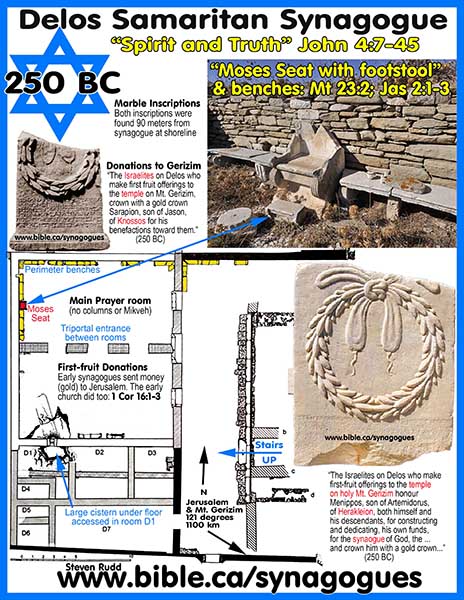
3. A spiritually hungry population of diaspora Jews on Delos rejoiced when a copy of the Septuagint arrived on their Island.
a. Their immediate reaction was to gather together to read the Law of Moses with the same zeal as Josiah when he found the lost book of the law in 623 BC.
b. This is how synagogues were born.
c. Although the law of Moses does not require weekly Sabbath assemblies, the desire to gather to read the bible and pray became a ubiquitous pattern through the Jewish community outside of Judea.
d. The movement finally made its way to Judea as a final stage of synagogue worship as a spiritual replacement for temple worship.
4. The transition from Temple to Synagogue to Church was all part of God’s eternal plan before the foundation of the world.
a. "knowing that you were not redeemed with perishable things like silver or gold from your futile way of life inherited from your forefathers, but with precious blood, as of a lamb unblemished and spotless, the blood of Christ. For He was foreknown before the foundation of the world, but has appeared in these last times for the sake of you who through Him are believers in God, who raised Him from the dead and gave Him glory, so that your faith and hope are in God. Since you have in obedience to the truth purified your souls for a sincere love of the brethren, fervently love one another from the heart, for you have been born again not of seed which is perishable but imperishable, that is, through the living and enduring word of God. For, “All flesh is like grass, And all its glory like the flower of grass. The grass withers, And the flower falls off, But the word of the Lord endures forever.” And this is the word which was preached to you." (1 Peter 1:18–25)
b. "“Men of Israel, listen to these words: Jesus the Nazarene, a man attested to you by God with miracles and wonders and signs which God performed through Him in your midst, just as you yourselves know— this Man, delivered over by the predetermined plan and foreknowledge of God, you nailed to a cross by the hands of godless men and put Him to death. “But God raised Him up again, putting an end to the agony of death, since it was impossible for Him to be held in its power." (Acts 2:22–24)
5. God’s eternal plan was that Synagogues began at Alexandria, Egypt in 280 BC as an intermediate bridge between Judaism and Christianity.
a. Today Temple worship is dead, extinct and impossible because there is not a Jew alive today that can trace his tribal ancestry, which is critical since only Levites can perform animal sacrifices.
b. What we have left today in Judaism is a religion that has no functional anchor in either the Old Testament or the New testament.
c. The church grew out of first century synagogue worship and had flowered into the largest religion in the world with over 3.5 billon adherents but there are only 15 million Jews in the world today, most of which are non-practicing.
By Steve Rudd 2017: Contact the author for comments, input or corrections
|
Jesus your messiah is waiting for you to come home! |
|
|
Why not worship with a first century New Testament church near you, that has the same look and feel as the Jewish Synagogue in your own home town. As a Jew, you will find the transition as easy today as it was for the tens of thousands of your forefathers living in Jerusalem 2000 years ago when they believed in Jesus the Nazarene (the branch) as their messiah. It’s time to come home! |
|
By Steve Rudd: Contact the author for comments, input or corrections.
Go to: Main Ancient Synagogue Start Page
